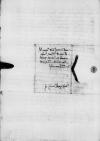Responderam paucis ante diebus illis ⌊⌋, quas ad me ex ⌊Hispania⌋ dederas. Unde nihil erat, quod denuo scriberem, sed cum Lodovicus hic canonicus collegii nostri istuc esset profecturus, admonuit me amor erga te meus, ne sine nostris ad te litteris eum paterer proficisci. Quin ide<m> amor et studium erga te effecit, ut illud ipsum nihil, quod erat, fieret aliquid vel invitis philosophis omnibus, qui ex nihilo contendunt nihil fieri posse. Nos in diem exspectamus, quod profeceritis cum ⌊rege catholico⌋ de hereditate ⌊dominae meae⌋. ⌊Ea⌋ sperat te ad causam magnum adiumentum allaturum tum serenissimi ⌊regis tui⌋, immo nostri, auctoritate et intuitu, tum tuo ipsius ingenio et industria. Idque ego de te audacter spondere ausus sum, unde conari te decet, ut bona fide et pro te et pro sponsore persolvas. Ex ⌊Sarmatia⌋ tua post editam a ⌊regina⌋ ⌊filiam⌋ nihil novi. In diem tamen exspectamus eum, qui iam quartum ab hinc mensem a ⌊domina mea⌋ cum muneribus ad puerperium spectantibus missus fuerat. Eum biduo antequam ⌊regina⌋ pareret constat pervenisse.
De caesare eligendo adhuc omnia incerta sunt. ⌊Gallorum rex⌋ incredibili et ante hac inaudita largitione electores et plerosque ⌊Germaniae⌋ principes adortus est. ⌊Rex Carolus⌋ noster neque deest sibi neque minoribus, ut aiunt, pollicitationibus rem gerit. Utcumque tamen ⌊Germaniam⌋ totam longe propensiorem ⌊familiae Haustriacae⌋, quam ⌊regi Galliae⌋ constat esse. Non desint, qui opinentur ⌊regem nostrum Poloniae⌋, si ad imperium eniti strenue adnitatur, non ultimae spei inter candidatos fore. Electores polliciti sunt ad Dominicam Rosae comitia se ingressuros ac fore, ut intra mensem tertium caesarem elegerint. Dii vertant bene. Sed ego velim abs te fieri certior de rebus Hispanis, ecquid loquuntur de caesare, ecquid de amicitia inter ⌊Gallum⌋ et ⌊Hispanum⌋ firmanda. Ea enim, quae istinc afferentur, tamquam fonti propinquiora, putabo verissima. De te vero ⌊domina mea⌋ diligenter perscripsit oratoribus suis, ut e nihilo secius tibi quam sibi ipsis nihil patiantur deesse. Sed tu interea fac, valeas et me ames.


 AAWO, AB, D. 3, f. 22v
AAWO, AB, D. 3, f. 22v